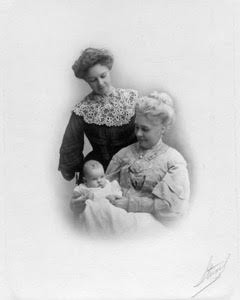by Laura Gonzales, Education & Volunteer Manager
Hello from your History Herald!
 You may be familiar with the Paloheimo name, Leonora and Y.A., the founders of our museum, but did you know that Leonora comes from a line of pretty remarkable women? Eva Scott Fényes, her daughter Leonora Scott Muse Curtin, and granddaughter Leonora Curtin Paloheimo were highly accomplished in the arts, science, business, and cultural preservation, leaving their mark on Santa Fe. The lives of these three women, spanning over 150 years, were champions of cultural preservation in the Southwest and together created a pretty remarkable female dynasty.
You may be familiar with the Paloheimo name, Leonora and Y.A., the founders of our museum, but did you know that Leonora comes from a line of pretty remarkable women? Eva Scott Fényes, her daughter Leonora Scott Muse Curtin, and granddaughter Leonora Curtin Paloheimo were highly accomplished in the arts, science, business, and cultural preservation, leaving their mark on Santa Fe. The lives of these three women, spanning over 150 years, were champions of cultural preservation in the Southwest and together created a pretty remarkable female dynasty.
Fényes was the daughter of a New York publisher. Her first husband, U.S. Marine Corps general W.S. Muse, was Leonora’s father. Her second husband was Hungarian nobleman and physician Adalbert Fényes. She first visited New Mexico in the 1880s and was quickly enthralled by its rich Spanish and Native American art and history. Their first home in Pasadena, California, is now the Pasadena Museum of History. Later, with her daughter and granddaughter, she completed their Santa Fe residence at 614 Acequia Madre in 1926. It is filled with antique furniture and artwork from the Southwest and Finland, as well as Depression-era tinwork, textiles, and furniture made for the Native Market cooperative, subsidized by Leonora Paloheimo. It was dubbed “the house of the three wise women” by friend, Charles Lummis, the famous journalist and preservationist.

Eva Scott Fenyes in Egypt
Eva was an accomplished artist, leaving behind hundreds of watercolor pieces, mostly of Southwestern adobe structures. She was also talented in oil painting, learning the art from famous American artist Sanford Gifford, who taught her while sailing the Nile during one of her tours of Egypt in 1869. Many of these works now reside in the Acequia Madre archives.
Her daughter, Leonora Scott Muse, married Santa Fe lawyer Thomas E. Curtin. After his death, she and her young daughter, the second Leonora, accompanied Eva on her world travels, developing their own passions and talents. During her childhood the youngest Leonora made frequent trips to Santa Fe with her mother and grandmother where she learned Spanish and developed a deep love and appreciation for local culture. Like her mother and grandmother before her, Leonora had a preservationist spirit and wanted to see the beautiful traditions of Santa Fe life maintained and celebrated. In Santa Fe, the two Leonoras were founding members of the Spanish Colonial Arts Society and purchased the La Cienega property that eventually became El Rancho de las Golondrinas.
Leonora Curtin was a student of Native American and Spanish-American Herbology and wrote the books Healing Herbs of the Upper Rio Grande and By the Prophet of the Earth. She was a talented ethnobotanist during a time when you didn’t see a lot of women in science. Leonora Paloheimo researched Native American languages for the Smithsonian Institution, and during the 1930s started Native Market to provide an outlet for the works of local craftsmen.

Leonora Curtin
In 1933 Leonora and her mother purchased Las Golondrinas for $15,000, paying the first $13,500 in cash and the rest in 200 sheep (how New Mexican of them)! She said there was “no plan to live at the ranch; it was to be a retreat where they could escape from the pressures of a too-active life in town and refresh themselves in the primitive simplicities of the country.” In 1945 she met Finnish Diplomat, Y.A. Paloheimo. The couple were soon married, and Y.A. quickly fell in love with the Ranch. By the 1960s Las Golondrinas had become a family home and year-round farm and ranch.
Through the years they worked to restore the historic structures to their former brilliance. It was during an afternoon stroll, while admiring the beauty and charm, that Y.A. was struck with the idea to develop an open air, living history museum, and El Rancho de las Golondrinas was born!
Opened in 1972, this year marks 48 years of preserving the beautiful history and culture of New Mexico and it still remains the perfect place to “escape the pressures of a too-active life.”

